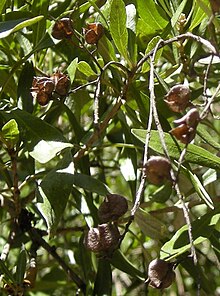Bursaria spinosa
| Bursaria spinosa | |
|---|---|
 |
|
| Scientific classification | |
| Kingdom: | Plantae |
| (unranked): | Angiosperms |
| (unranked): | Eudicots |
| (unranked): | Asterids |
| Order: | Apiales |
| Family: | Pittosporaceae |
| Genus: | Bursaria |
| Species: | B. spinosa |
| Binomial name | |
|
Bursaria spinosa Cav. |
|
| Synonyms | |
|
|
Bursaria spinosa is a small tree or shrub in the family Pittosporaceae. The species occurs in mainly in the eastern and southern half of Australia and not in Western Australia and the Northern Territory. Reaching 10 m (35 ft) high, it bears fragrant white flowers at any time of year but particularly summer. A common understory shrub of eucalyptus woodland, it aggressively colonises disturbed areas and fallow farmland. It is an important food plant for several species of butterflies and moths, particularly those of the genus Paralucia.
First collected in the vicinity of Port Jackson, Bursaria spinosa was first described by Antonio José Cavanilles in 1797. It is known by many common names, including Australian blackthorn, blackthorn, Christmas bush, mock orange, native blackthorn, native box, native olive, prickly box, prickly pine, spiny box, spiny bursaria, sweet bursaria, thorn box and whitethorn. Summer flowering has given rise to the name (Tasmanian) Christmas bush in Tasmania and South Australia (not to be confused with Prostanthera lasianthos). Indigenous names recorded include kurwan in Coranderrk, Victoria, and geapga from Lake Hindmarsh Station.
Bursaria spinosa is highly variable in appearance and habit, as are other species within the genus, and there have been several attempts at classification since their discovery. The Austrian botanist Aloys Putterlick divided Bursaria spinosa into spiny (spinosa) and lacking spines (inermis) in 1839. Several subspecies have been described, but a 1999 revision of the genus recognises only two, one of which B. spinosa lasiophylla had been considered a separate species.
Thus subspecies spinosa is a 5–10 m shrub or tree found widely across eastern Australia and Tasmania from the Eyre Peninsula, Flinders Ranges and Kangaroo Island in South Australia to north Queensland. Subspecies lasiophylla has shorter, wider leaves and smaller flowers and only reaches 5 m. It replaces the other subspecies on heavier clay soils in southeastern Australia (eastern South Australia and southern New South Wales).
...
Wikipedia
